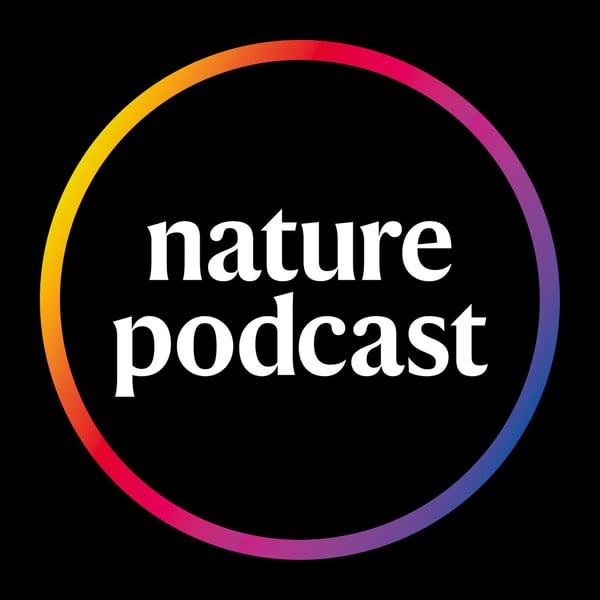A brand-new colour created by lasers, a pig-liver transplant trial gets the green light, and a nugget-sized chunk of lab-grown meat
Nature Podcast
[email protected]
4.4 • 859 Ratings
🗓️ 23 April 2025
⏱️ 20 minutes
🧾️ Download transcript
Summary
00:27 Five people see ‘olo’, a brand-new colour
Using a laser system to activate specific eye cells, a team has allowed five study participants to perceive a vibrant blue-greenish hue well outside the natural range of colours seen by humans. Although the setup required to accomplish this feat is currently complicated, this finding could provide more understanding about how the brain perceives colour and could one day help boost the vision of people with colour blindness.
Nature News: Brand-new colour created by tricking human eyes with laser
08:30 US regulator greenlights pig-liver transplant trial
The US Food and Drug Administration has approved the first trial to test whether genetically modified pig livers can be used safely to treat people with organ failure. In the initial phase of the trial, four people with severe liver failure will be temporarily connected to an external pig liver that will filter their blood. Participants will then be monitored for a year for safety and changes in liver function. The organs have been genetically modified to make them more compatible with humans.
Nature News: Pig livers for people: US regulator greenlights first safety trial
14:08: A chunk of lab-grown chicken
Using a designer ‘circulatory system’, a team of researchers have created what they think is the largest piece of meat grown in the laboratory yet. One of the challenges to producing larger pieces of lab-grown meat has been providing cells with sufficient oxygen and nutrients, something the team’s new setup helps overcome. They used it to grow a chunk of chicken muscle about the size of a nugget, but multiple challenges remain before meat produced in this way could make it to market.
Nature News: Winner, winner, lab-made dinner! Team grows nugget-sized chicken chunk
Hosted on Acast. See acast.com/privacy for more information.
Transcript
Click on a timestamp to play from that location
| 0:00.0 | Hi listeners, Benjamin here. As is tradition around this time of year, we're going to do something |
| 0:08.9 | a little bit different on the nature podcast this week. We're going to do a deep dive into some of the |
| 0:13.6 | stories that have been in the nature briefing. And joining me to do so is a crack team of science |
| 0:19.6 | journalists. We've got Charmany Bundell. Shalmany, |
| 0:21.9 | how are you doing today? Hey, are doing great. Excellent. And Lizzie Gibney. Lizzie, hello. |
| 0:26.3 | Hello, Ben. Thanks for having me. So, three stories to talk about today. Let's go with one, |
| 0:30.9 | Lizzie, that you've been covering for nature. And it's a story about a new colour. |
| 0:37.7 | It is. And I think this is amazing because it's all about about a new colour. It is. |
| 0:39.0 | And I think this is amazing because it's all about how your brain actually interprets colour, |
| 0:43.1 | which I don't think I really had fully comprehended before I wrote this story. |
| 0:46.4 | Color is all a bit of illusion, is my takeaway from this. |
| 0:50.4 | But it's a new colour. |
| 0:51.2 | It's a kind of bluey, greenish colour, but by definition, we can't quite describe what it is with words or even to show you because you only see it under very, very specific conditions. |
| 1:02.5 | But yeah, five people, five participants in the study have been the only ones in the world ever, as far as we can tell, to see this colour, which is a very, |
| 1:11.3 | very intense, vibrant, they call it saturated, bluey green. Yeah, this is a slight change for you |
| 1:16.8 | from all the physics, because yes, obviously, how we see colour depends on the cells in our eyes. |
| 1:22.7 | And that's kind of how they've made the new colour, isn't it, with the cells in your eyes? Exactly. So it involves light, so that is definitely in my wheelhouse. Light and photons. Yes, |
| 1:30.3 | thank you. But no, it is all about cells. So the way that we see colour, okay, is you have three |
| 1:35.2 | of these different light receptor cell in the eye, and these are called cones. And they all see a |
| 1:39.0 | different range of wavelengths of light. But those ranges overlap each other. So what happens is when you see one |
| 1:46.7 | colour, you get a colour coming in, your brain actually is getting three different numbers. It's |
| 1:51.7 | getting how much does each of those cones fire? And it's almost like those numbers, the cones |
... |
Transcript will be available on the free plan in 24 days. Upgrade to see the full transcript now.
Disclaimer: The podcast and artwork embedded on this page are from [email protected], and are the property of its owner and not affiliated with or endorsed by Tapesearch.
Generated transcripts are the property of [email protected] and are distributed freely under the Fair Use doctrine. Transcripts generated by Tapesearch are not guaranteed to be accurate.
Copyright © Tapesearch 2025.

